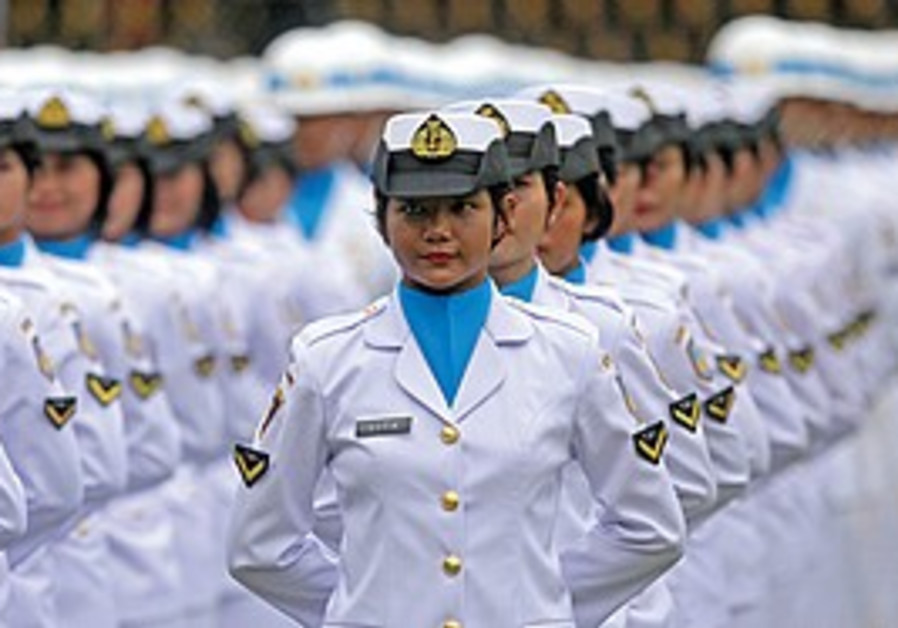https://www.jpost.com/International/From-Israel-to-Indonesia-with-love
BY ABE SELIG
AUGUST 18, 2010 05:13How an Israeli entrepreneur forged stronger ties with the world’s largest Muslim country.

Indonesian sailors. (photo credit: Associated Press)
When Steve Stein first broached the idea of bolstering ties between Israel and Indonesia – the world’s largest Muslim country, and one with no official diplomatic relations with the Jewish state – he often met with the same response.
“People told me it will never happen – don’t waste your time,” Stein recalled as he spoke to The Jerusalem Post this week.
“People told me it will never happen – don’t waste your time,” Stein recalled as he spoke to The Jerusalem Post this week.
But that was in 1992, predating even Israel’s official peace accord with the Hashemite Kingdom of Jordan, which was signed two years later.
“In those days,” Stein said of Israel’s relationship with the Arab and larger Muslim world, “there was [Israel’s 1979 peace accord with] Egypt, and then there was everyone else.”
But Stein didn’t let that stop him.
The same year, he arrived in the Indonesian capital of Jakarta for the first time and began sowing the seeds of what has become a nearly 20- year venture.
“I started with a vision to try and make a difference,” Stein said.
“To try and change perceptions by engaging people.”
Using that vision, Stein’s efforts over the past two decades have included successful attempts to increase trade as well as to boost medical cooperation between the Indonesian health services and Israel’s Rambam Hospital and Magen David Adom.
But none of this has been easy. “I’ve poured my life into this over nearly two decades,” Stein said, “because I know that it’s for the benefit of both the Indonesian people and the people of Israel.”
Stein’s first real break came in 1997 when, after five years of shuttling between Tel Aviv and Jakarta, he became a consultant to an Indonesian state-owned insurance company, Asuransi Jasindo, and was tasked with promoting trade and investments between Israeli and Indonesian companies.
Less than three years later, in February 2000, those efforts paid off when Indonesian Minister of Industry and Trade Yusuf Kalla removed all commercial barriers in the private sector between the two countries, and companies in Indonesia and Israel began trading with one another directly.
A month later, the first bilateral protocol agreement was signed between Asuransi Jasindo and Assure Ltd. of Israel, providing export credit insurance for importers and exporters from both countries.
The same month, Asuransi Jasindo announced it was opening its first international representative office in Israel.
The following years saw the continued loosening of trade restrictions between the two countries – including joint agreements between several Israeli and Indonesian banks – and in 2003, the removal of required import licenses on most products imported from Indonesia and Malaysia to Israel.
As the trade doors continued to open, however, Stein and his Indonesian counterparts were caught off guard by the massive destruction the 2004 Indian Ocean tsunami wreaked on Indonesia’s coastal communities.
“It was at that point that the poor state of Indonesia’s humanitarian and health services became so tragically apparent,” Stein said.
“In those days,” Stein said of Israel’s relationship with the Arab and larger Muslim world, “there was [Israel’s 1979 peace accord with] Egypt, and then there was everyone else.”
But Stein didn’t let that stop him.
The same year, he arrived in the Indonesian capital of Jakarta for the first time and began sowing the seeds of what has become a nearly 20- year venture.
“I started with a vision to try and make a difference,” Stein said.
“To try and change perceptions by engaging people.”
Using that vision, Stein’s efforts over the past two decades have included successful attempts to increase trade as well as to boost medical cooperation between the Indonesian health services and Israel’s Rambam Hospital and Magen David Adom.
But none of this has been easy. “I’ve poured my life into this over nearly two decades,” Stein said, “because I know that it’s for the benefit of both the Indonesian people and the people of Israel.”
Stein’s first real break came in 1997 when, after five years of shuttling between Tel Aviv and Jakarta, he became a consultant to an Indonesian state-owned insurance company, Asuransi Jasindo, and was tasked with promoting trade and investments between Israeli and Indonesian companies.
Less than three years later, in February 2000, those efforts paid off when Indonesian Minister of Industry and Trade Yusuf Kalla removed all commercial barriers in the private sector between the two countries, and companies in Indonesia and Israel began trading with one another directly.
A month later, the first bilateral protocol agreement was signed between Asuransi Jasindo and Assure Ltd. of Israel, providing export credit insurance for importers and exporters from both countries.
The same month, Asuransi Jasindo announced it was opening its first international representative office in Israel.
The following years saw the continued loosening of trade restrictions between the two countries – including joint agreements between several Israeli and Indonesian banks – and in 2003, the removal of required import licenses on most products imported from Indonesia and Malaysia to Israel.
As the trade doors continued to open, however, Stein and his Indonesian counterparts were caught off guard by the massive destruction the 2004 Indian Ocean tsunami wreaked on Indonesia’s coastal communities.
“It was at that point that the poor state of Indonesia’s humanitarian and health services became so tragically apparent,” Stein said.
Indonesia had the highest death toll of all the countries affected by the tsunami, with the final number of fatalities resting at between 130,000 and almost 170,000 people.
Stein was asked to facilitate Israel’s humanitarian response, and immediately began arranging landing permits and logistical support for the storage and distribution of aid packages – including baby food, medicine, blankets, rice, sugar, bottled water, water-purifying machines, communication devices and more.
“All of it was donated by the people and private sector of Israel,” Stein stressed.
“Israel was one of the first countries to offer assistance,” he added. “And two weeks after the first waves had hit shore, we successfully airlifted 75 tons of humanitarian aid to a designated airport in Indonesia.”
While Stein’s efforts in the business sector continued, he increasingly began to shift his focus toward the humanitarian and social challenges facing Indonesia, where nearly 20 percent of its almost 250 million inhabitants live below the poverty line.
“Indonesia needed medical training – that became apparent during the tsunami,” Stein said. “And Israel has some of the best medical services the world can offer.”
Additionally, Stein added, Israeli medical personnel have expertise in the treatment of mass casualties – a jarring but realistic outcome of the country’s own history with terror attacks and bombings.
“While Israel has learned to deal with mass casualties for [its] own reasons, Indonesians suddenly saw the huge importance of it as well,” Stein said.
So in 2006, Prof. Aryono Pusponegoro, president of Indonesia’s surgeons association and chairman of more than 100 of the country’s emergency ambulance services, was invited to Israel by Magen David Adom – an event Stein helped facilitate.
“During his visit, Pusponegoro attended a national drill that simulated a major terror attack with mass casualties, featuring the participation of police, firefighters, military, air force and MDA emergency ambulance services,” Stein said.
“It was a big success,” he added. “And we decided to begin promoting similar efforts as well.”
In 2008, 23 doctors from throughout Indonesia arrived in Tel Aviv for a two-week workshop with MDA personnel on the “Management of Multi- Casualty Incidents.” During the workshop, the doctors learned about Israel’s EMS services, as well as new methods to provide better, faster medical care to their patients.
From there, MDA began increasing its cooperation with Indonesia’s medical services, and later that year it signed an agreement in Tel Aviv with Indonesian medical representatives that would boost MDA’s involvement in training Indonesian paramedics – both in Israel and in Indonesia.
Stein was asked to facilitate Israel’s humanitarian response, and immediately began arranging landing permits and logistical support for the storage and distribution of aid packages – including baby food, medicine, blankets, rice, sugar, bottled water, water-purifying machines, communication devices and more.
“All of it was donated by the people and private sector of Israel,” Stein stressed.
“Israel was one of the first countries to offer assistance,” he added. “And two weeks after the first waves had hit shore, we successfully airlifted 75 tons of humanitarian aid to a designated airport in Indonesia.”
While Stein’s efforts in the business sector continued, he increasingly began to shift his focus toward the humanitarian and social challenges facing Indonesia, where nearly 20 percent of its almost 250 million inhabitants live below the poverty line.
“Indonesia needed medical training – that became apparent during the tsunami,” Stein said. “And Israel has some of the best medical services the world can offer.”
Additionally, Stein added, Israeli medical personnel have expertise in the treatment of mass casualties – a jarring but realistic outcome of the country’s own history with terror attacks and bombings.
“While Israel has learned to deal with mass casualties for [its] own reasons, Indonesians suddenly saw the huge importance of it as well,” Stein said.
So in 2006, Prof. Aryono Pusponegoro, president of Indonesia’s surgeons association and chairman of more than 100 of the country’s emergency ambulance services, was invited to Israel by Magen David Adom – an event Stein helped facilitate.
“During his visit, Pusponegoro attended a national drill that simulated a major terror attack with mass casualties, featuring the participation of police, firefighters, military, air force and MDA emergency ambulance services,” Stein said.
“It was a big success,” he added. “And we decided to begin promoting similar efforts as well.”
In 2008, 23 doctors from throughout Indonesia arrived in Tel Aviv for a two-week workshop with MDA personnel on the “Management of Multi- Casualty Incidents.” During the workshop, the doctors learned about Israel’s EMS services, as well as new methods to provide better, faster medical care to their patients.
From there, MDA began increasing its cooperation with Indonesia’s medical services, and later that year it signed an agreement in Tel Aviv with Indonesian medical representatives that would boost MDA’s involvement in training Indonesian paramedics – both in Israel and in Indonesia.
But with all these developments continuing to unfold, Stein said he had no plans of slowing down.
“My vision is to continue working with private fundraisers and NGOs, in both countries and overseas, who share the same vision and who have faith in our abilities to create better understanding between the people of Indonesia and Israel,” Stein said.
“In the case of Indonesia, I have seen with my own eyes how these efforts are helping people on the ground, in communities across the country,” he asserted. “It’s worked. It’s proven to be beneficial for both Indonesia and Israel, and I believe it will only continue to do so.”
“In the case of Indonesia, I have seen with my own eyes how these efforts are helping people on the ground, in communities across the country,” he asserted. “It’s worked. It’s proven to be beneficial for both Indonesia and Israel, and I believe it will only continue to do so.”






























